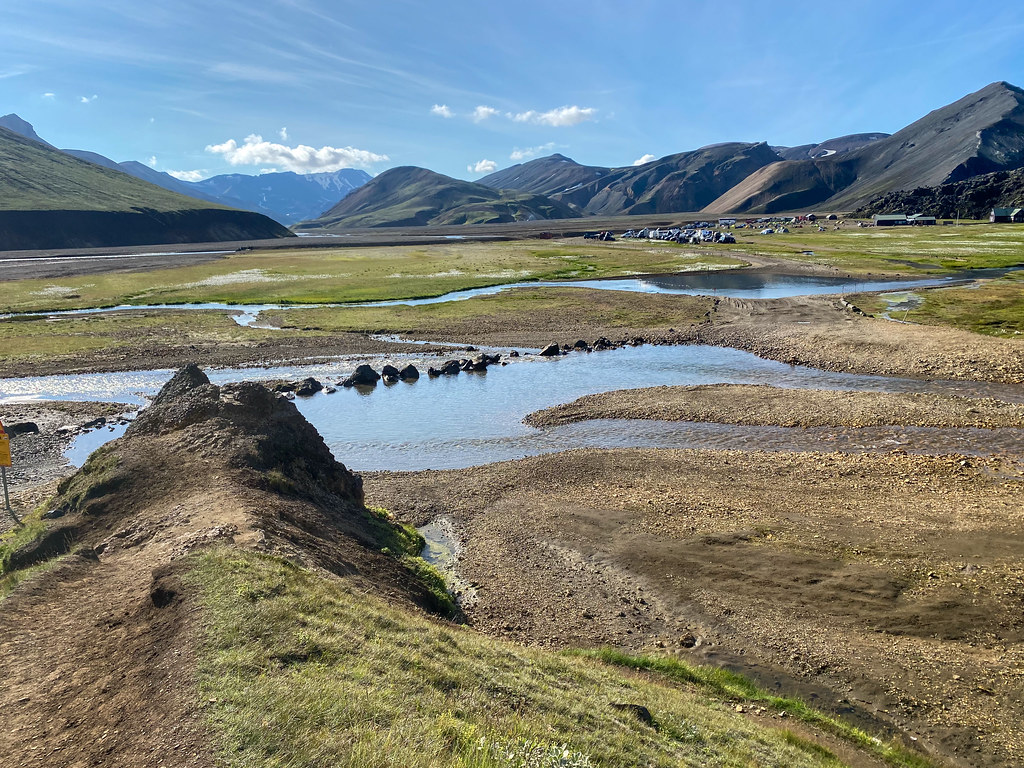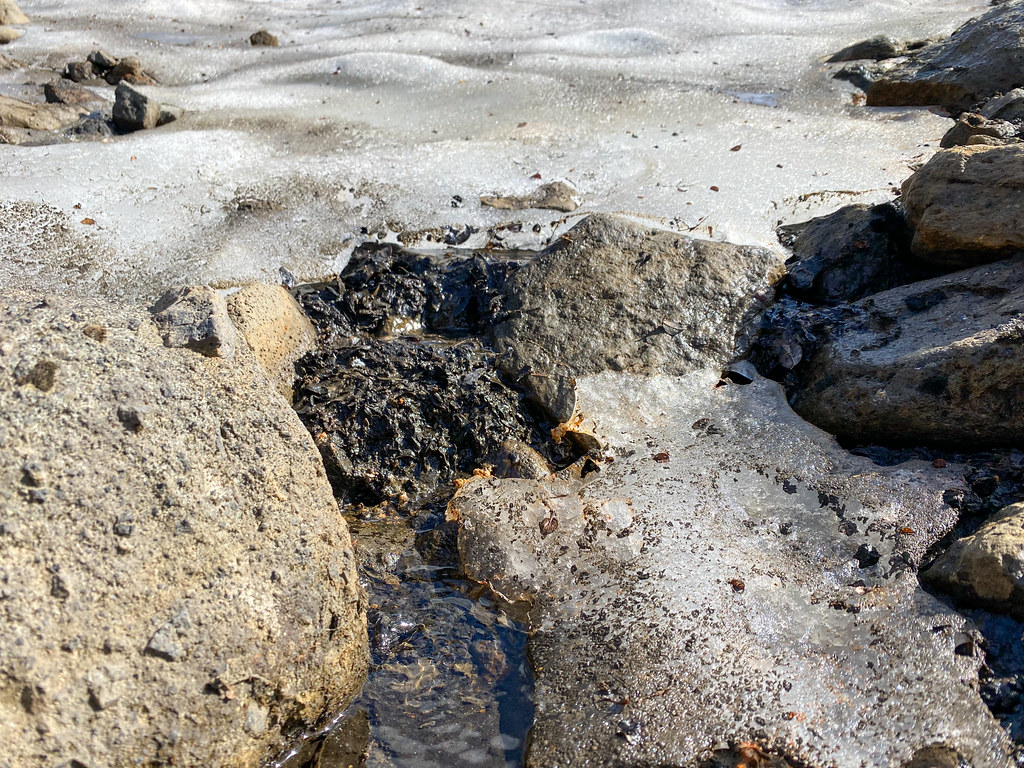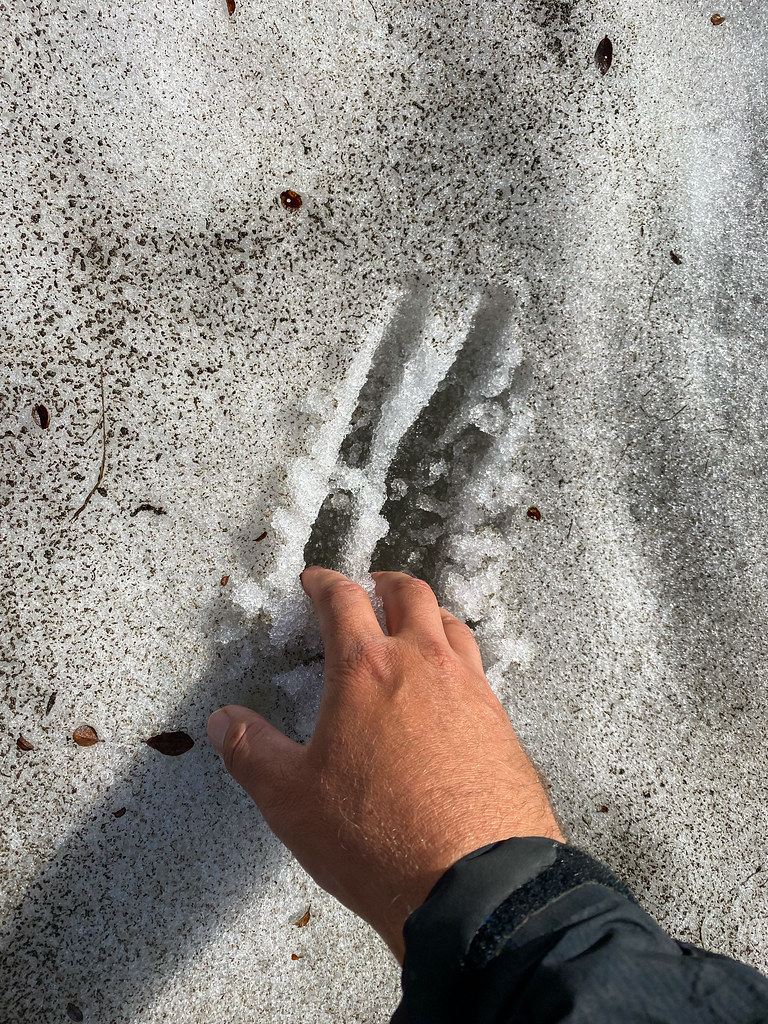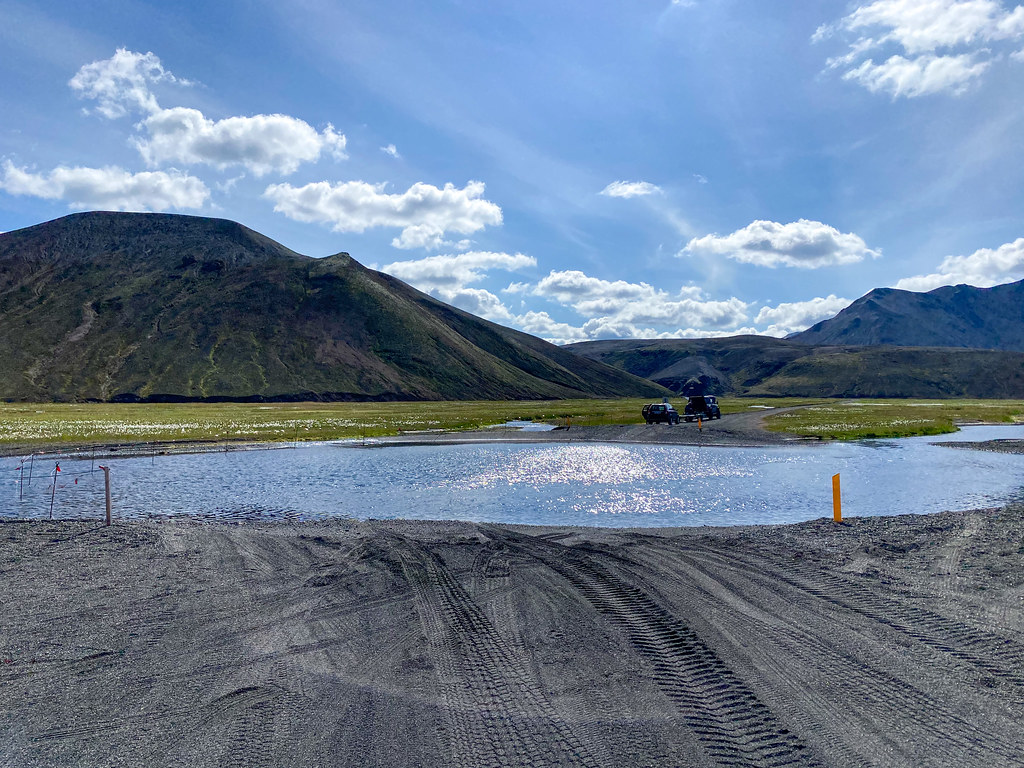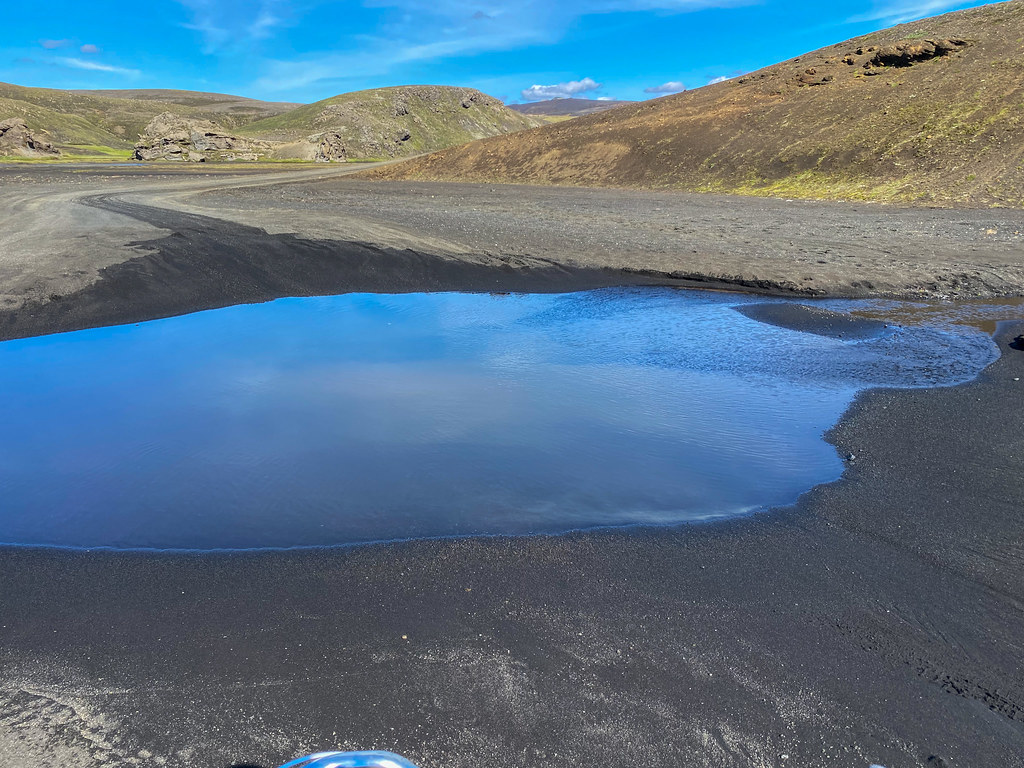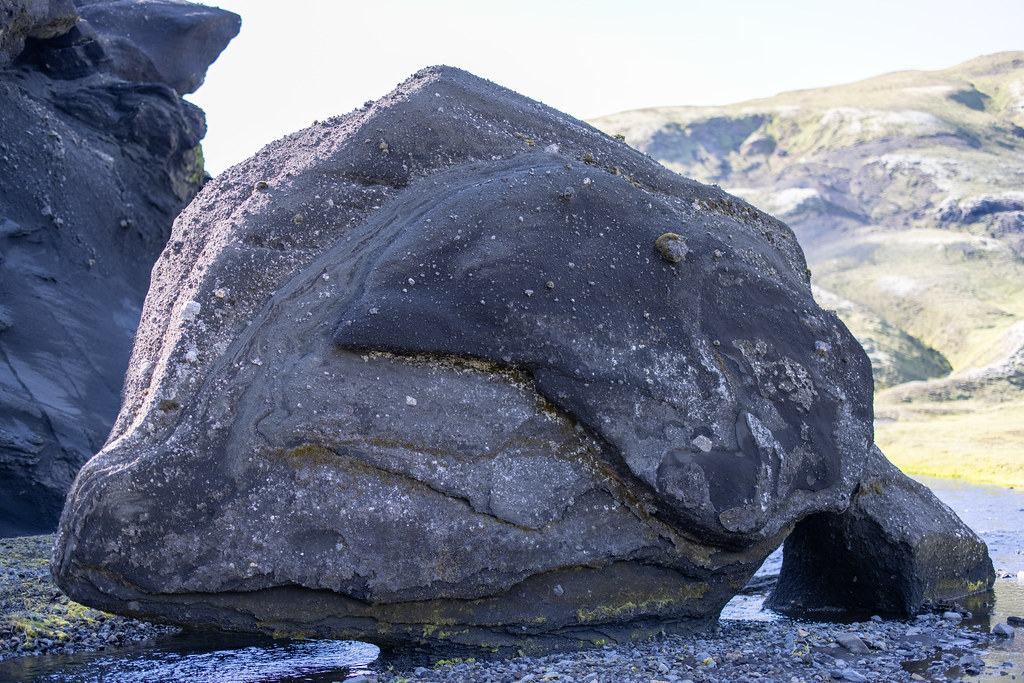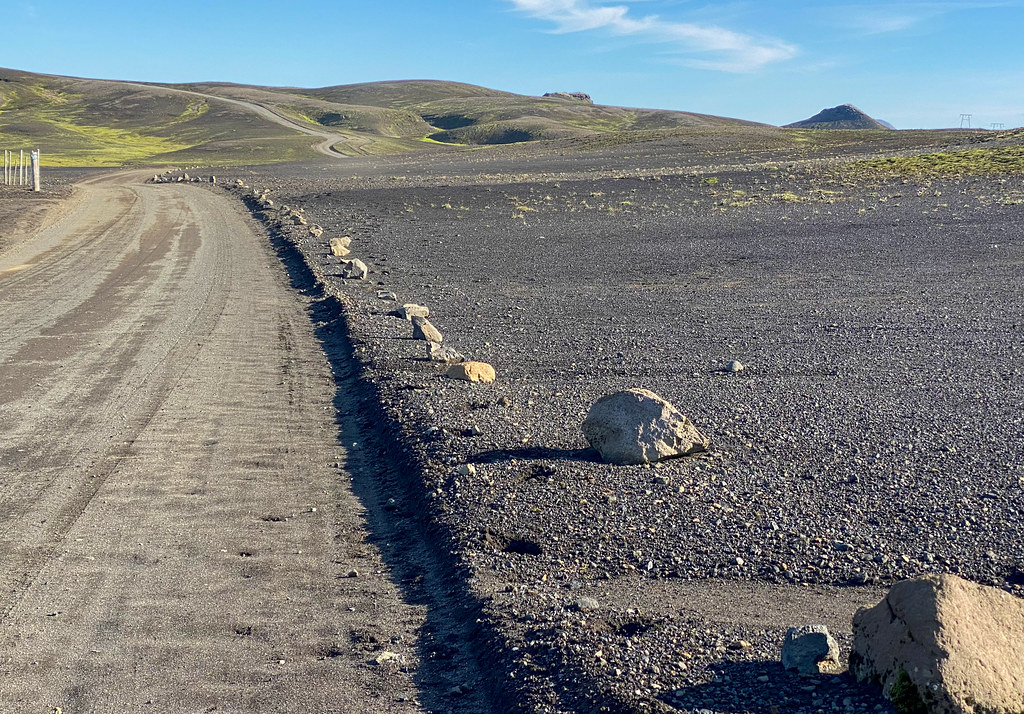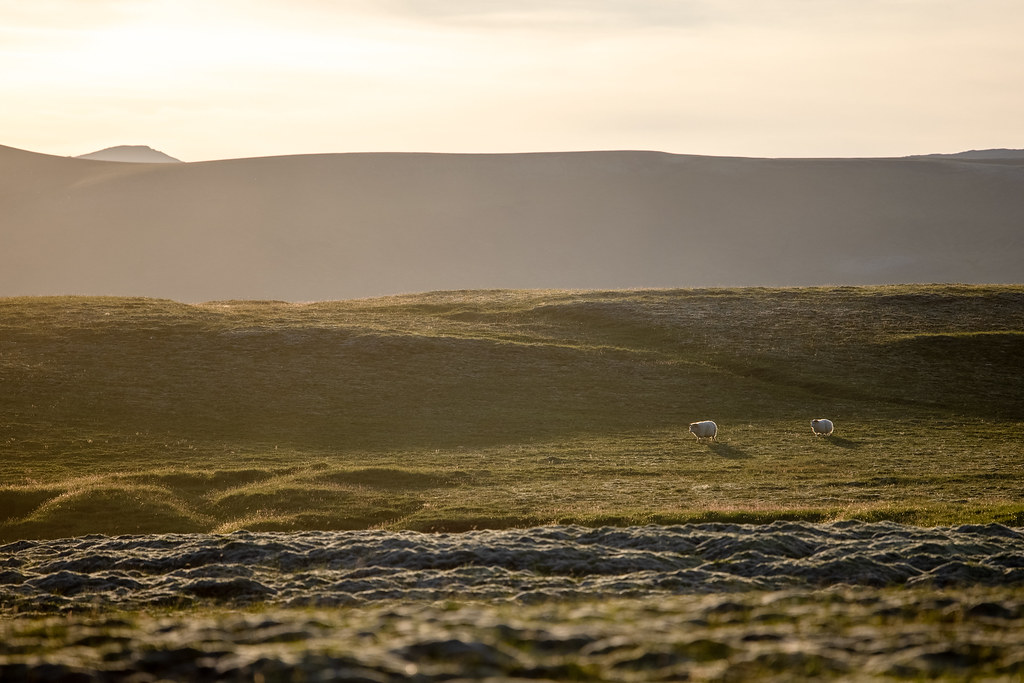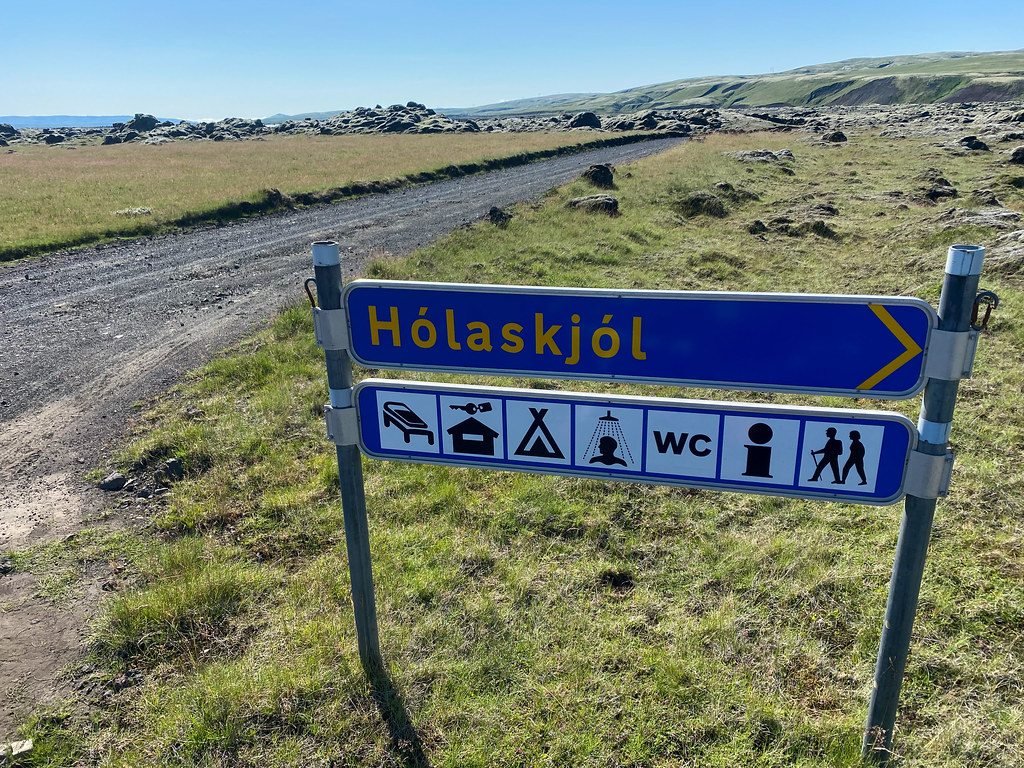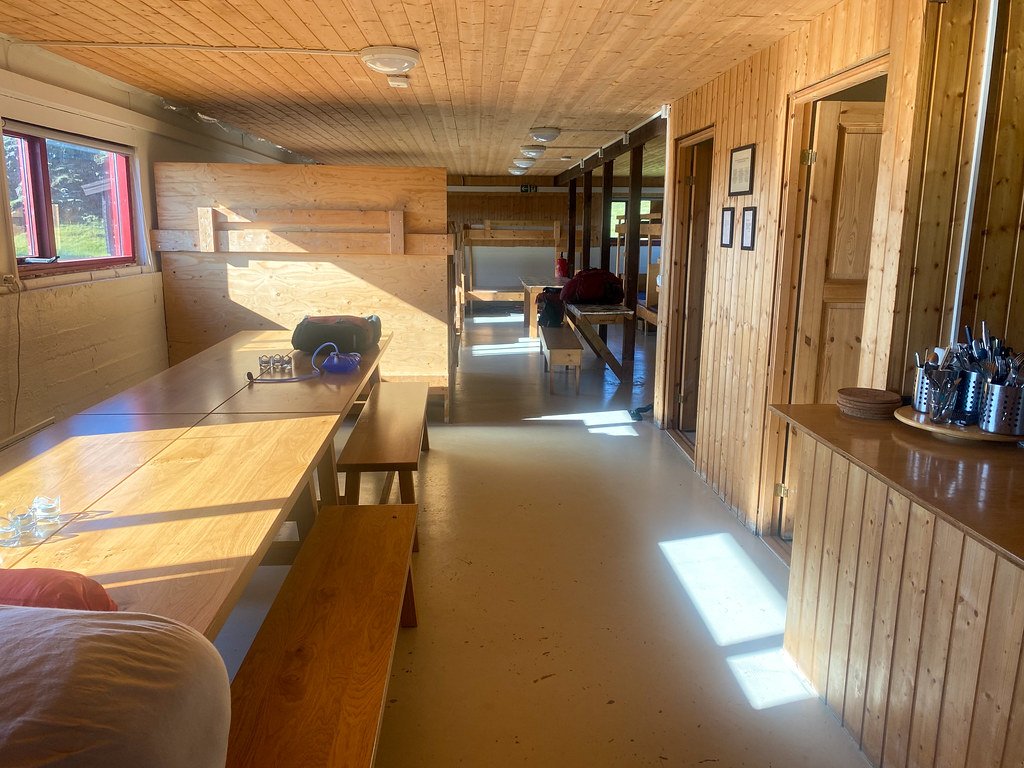Glaciers and plains
August 13, 2021 Filed under Curious
The day started nervously. I inflated the front tire to 90 PSI again, but as soon as I rolled onto flat pavement I noticed it was bumping rhythmically, much more than before. The warp was getting worse, faster than the leak in the tube.
I hit the all-in-one convenience store for the last time, and bought two Prince Polos, a banana, two chocolate muffins, and a large carton of milk. I strapped the carton to the back of the bike, where it’s visible to passing motorists. I like to think it amuses them.
The temperature was fine but the wind was against me. About 10mph, pushing into the bike. With over 50 miles to cover I knew I would be in the saddle for the whole day — and worrying about the front tire every minute of it.
But, it’s hard to stay worried when you’re seeing stuff like this.
A few miles east I found the pie shop I’d seen on the map. Having a stubborn nature paradoxically means that you sometimes insist on slowing down and relaxing even when you’re worried about getting somewhere. As I parked the bike next to a table sporting a delightful view of the waterfall, I thought of the story my Mom liked to tell about my grandfather’s stubbornness:
He was on a months-long expedition, going up the Alaska-Canada highway, riding shotgun in a truck with my father. My father had every day scheduled and booked in advance, and wanted to get to the next place with as much time to look around as possible, so he was not inclined to stop. My grandfather checked his watch and, seeing it was early afternoon, and considering the trip to be the vacation it definitely was, said “It’s cocktail time. Pull over and let’s take a break.”
Looking around at the trees, my father said, “Why would we stop here? There’s nothing interesting.”
“Because it’s cocktail time,” grandad repeated.
“Let’s just keep going and we can relax when we get to town.”
“Cocktail time is now,” my grandfather said.
“So?” said my Dad, irritated.
Whereupon my grandfather scooted over to the middle of the cab and awkwardly shoved his leg into the footwell across the center divider, and pressed down on the brake.
“We’re stopping,” he declared.
“Fine, fine! Fine. We’re stopping!” said Dad, with bad grace, and turned the truck towards the shoulder. “Let me just park.”
And so granddad walked around for a bit, then pulled a folding chair out of the back and had a beverage, and probably smoked a cigar.
I definitely take after him.
The nice lady behind the counter mis-heard me and brought me the wrong slice of pie, but it was delicious. I sat outside next to the bike, gazing at the water tumbling over the cliff, eating slowly, and listening to an audiobook.
There really are few things finer in adult life than being able to take exactly as much time as you want doing a thing. I spent half an hour eating one slice of pie.
For two hours afterward I traveled on highway that was almost perfectly flat, and I would have made great time except for the wind and the tire, which I had to pump up about 10 PSI every half-hour.
More moss-covered weirdness came into view. More terrain I hadn’t seen anywhere else in the world. Maybe again in Norway, if I ever got there…
Then, at long last, I caught sight of a full-on glacier. This was something I almost completely missed on my northern route two years before.
The terrain evolved slowly, and the glacier passed out of sight. Before I could see it again I was forced to stop when the front tire suddenly went completely flat. Uh oh…
I knew how this had to go. A lumpy tire was a damaged tire. If I was lucky, this flat would be unrelated to the damage. It would just be some random bit of debris poking through the tread like usual, and I could apply a patch and get back on the road. If I was unlucky, the flat would be caused by the damage, and I would now be getting an endless parade of flats, each sooner than the last, until I couldn’t even push the bike next to me.
Time for the usual routine. I shoved the bike to a wide patch of shoulder, stripped all the bags off, flipped the bike, removed the wheel, and peeled the tire away from the rim.
At the time I was too focused on dealing with the problem to take pictures, but here are a few from farther ahead in the trip:
Long story short, the wire belt inside the tire that helps to prevent flats was so damaged it was causing them instead. Little bits of Kevlar were twisted up out of the belt and scraping against the tube. I applied most of my remaining tire patches to the inside of the tire, trying to make a protective layer for the tube, but the damage kept spreading. I would need a replacement very soon.
I reassembled everything, then inflated the tire about 2/3 of the way. I was trying to balance between the damage of the tire flexing against the tube as it rolled, and the ongoing disintegration of the tire due to high pressure. If the thing spit apart completely, the bike wouldn’t even roll, and I would have to flag down a motorist.
For now, there was nothing to do but pedal and enjoy the scenery.
And the scenery was marvelous!
Educational as well. I learned a few things about the early explorers of the highlands.
The road remained flat, which was a blessing. I didn’t need to put extra pressure on the tire by using the brakes. I checked it every half an hour or so, but the tube was holding, and the lumpiness of the ride seemed to be constant. I kept myself braced for a sudden explosion.
But, sometimes I just forgot about the tire completely, because Iceland is freaking gorgeous!
Maybe Icelandic mutton tastes better because the sheep enjoy a nicer view? I can’t decide.
One of the turnouts I stopped at was arranged around a weird chunk of wreckage, which was a bit of a mystery at first.
The billboards explained that Icelanders had tried multiple times to make an enduring road across this terrain and been thwarted by unexpected floods. They built larger and tougher bridges, which were all eventually destroyed, and then they moved to another approach: Build a cheap one that’s easier to get in and repair!
It struck me as very Icelandic, that the builders of this road would decide to entertain travelers with a series of lessons in construction and engineering. In other parts of the world this accomplishment would be lost in the general noise, or treated as the concern of civic planners only.
You might say it’s optimistic of them to believe that tourists would be interested in this stuff, but on the other hand, here I am being a tourist and totally enjoying it. I guess they know their audience!
There were signs with more vital information, of course. All of it designed to discourage people from getting too adventurous on terrain that would be hard to rescue them from.
At this point I couldn’t go off the beaten path even if I wanted to. I knew my tire was damaged because of all that hard gravel road, and I dreaded what would happen if I went off this smooth highway even for a minute.
Late in the day I passed over one of the flood areas that had so vexed the engineers from years past. Look at all that rock dust!
Shortly after that I passed through a small town that had the Iceland equivalent of those midwestern gas station mega-stores. There was a crowded restaurant in the back, serving people cafeteria-style with trays. I paid one price and then came back three times for more fish, and wrapped the third round up in some foil to take on the road. It was a really good deal!
Just across the road from the restaurant, the glacier was close at hand. My stomach was full but I still wanted dessert, so the first thing that came to mind when I saw this was a giant powdered-sugar donut the size of a country. Mmmm…
This would turn out to be the closest I got to a glacier this trip.
Eventually I reached the hotel. It was expensive but strategically placed, being the only shelter for 30 miles in either direction. With permission I could have camped on the private land on either side of the road, but I had no idea who to contact and didn’t want to upset any locals.
There was nobody at the desk, just a bunch of keys scattered on top with labels attached. I picked out the one with my name and found the room on the second floor, up some narrow stairs. It would be really awkward carrying the bike through here.
Luckily the hotel was built into a hill, so my second floor window opened to a parking lot in the back. I wheeled the bike around and passed everything in though the window, then turned the bike over and removed the front wheel, and passed that inside too.
When I took the tube out, I found another leak just on the edge of a patch I’d applied before. I patched that, then hammered fruitlessly at the shreds of kevlar that were poking up inside the tire. They wouldn’t bend, and they were too short to cut with anything. I used up my last patch to cover some of them, then lined the tube up inside the tire as best I could for reassembly in the morning. The tire was visibly warped in one spot now. I desperately needed a new one.
I searched for bike shops, then online shippers. In due time I learned that no one, anywhere in the country, sells a 20-inch bicycle tire. There were online stores that could probably ship to Iceland, but on what timescale? Weeks? Months? I would probably have to email back and forth with them for a while just to negotiate faster shipping, and it was Friday, so I would be waiting another three days just to get the first answer. The longer the wait, the more uncertain I would be about where to have the item shipped. What else could I do?
I devoured some snacks and pondered.
I looked at the map again, then called my nephew all the way back in California to chat about the situation. With my guidance, he went poking around in the garage and located a spare 20-inch tire, plus a tube, and passed them to my sister. Soon after that she drove across town to a DHL shipping center, half an hour before it closed for the weekend. For a total of 250 dollars – double the cost of my room for the night – a tire and tube began the journey partway around the planet, to arrive in the town of Höfn in about a week, the nearest town ahead of me large enough to have a post office. It was a calculated risk, since I’d need to cover 75 mile miles to get there.
I thanked my nephew and my sister profusely, and sent them 250 bucks over the wires.
“It’s great to have people who love you,” I thought. “The people who owe you a favor, they will do things for you up to a limit and then consider the debt paid. But people who love you, they will do what it takes, because of who you are, and that’s a currency with no fixed exchange rate.”
Pondering my good fortune, I quickly fall asleep tucked into the one bed I haven’t blanketed with gear.





































































































